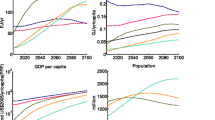Abstract
In integrated assessments of climate change, greenhouse-gasemissions and climate change impacts provide the linkages betweenthe world economy and the climate system. Key climatic processesoperate at the scales of centuries. This requires highlyaggregated models for portraying the dynamics of the economicsystem. An extended Ramsey-type optimal growth model is presentedas the appropriate tool to be integrated with a reduced-formclimate model in the ICLIPS integrated assessment. Theeleven-region model of the world economy involves exogenouspopulation and endogenous investment dynamics with productivityprogress based on a technological diffusion model. World regionsare linked via intertemporal trade flows of the compositeconsumption/investment good, capital mobility, and emission permittrading. Coupled with the ICLIPS Climate Model, the AggregatedEconomic Model can determine corridors of permitted long-termcarbon emission paths or, as primarily discussed in this paper,specific cost-effective emission trajectories. The sensitivity ofmitigation costs to externally specified climate change/impactconstraints and to assumptions about non-CO2 greenhouse-gasemissions is also discussed.
Similar content being viewed by others
References
Ciscar, J.-C. and Soria, A.: 2000, ‘Economic Convergence and Climate Policy’, Energy Policy 28, 749–761.
Dixon, P. B.: 1975, The Theory of Joint Maximization, North-Holland Publishing Company, Amsterdam, The Netherlands.
Edmonds, J., Wise, M., Pitcher, H., Richels, R., W igley, T. M. L., and MacCracken, C.: 1996, ‘An Integrated Assessment of Climate Change and the Accelerated Introduction of Advanced Energy Technologies: An Application of MiniCAM 1.0’, Mitigation and Adaptation Strategies Global Change 1(4), 311–339.
Füssel, H.-M., Toth, F. L., van Minnen, J. G., and Kaspar, F.: 2003, ‘Climate Impact Response Functions as Impact Tools in the Tolerable Widows Approach’, Clim. Change, this issue.
Gritsevskyi, A. and Schrattenholzer, L.: 2003, ‘Costs of Reducing Carbon Emissions: An Integrated Modeling Framework Approach’, Clim. Change, this issue.
Grübler, A. and Messner, S.: 1998, ‘Technological Change and the Timing of Mitigation Measures’, Energy Economics 20 (5/6), 495–512.
Ianchovichina, E., McDougall, R., and Hertel, T.: 1999, A Disequilibrium Model of International Capital Mobility, Working Paper, Center for Global Trade Analysis, Purdue University, West Lafayette, IN.
IPCC (Intergovernmental Panel on Climate Change): 1996, Climate Change 1995: The Science of Climate Change, The Contribution of Working Group I to the Second Assessment Report of the Intergovernmental Panel on Climate Change. Houghton, J. P., Meira Filho, L. G., Callendar, B. A., Kattenberg, A., and Maskell, K. (eds.), Cambridge University Press, Cambridge, U.K.
IPCC (Intergovernmental Panel on Climate Change): 2000, Special Report on Emissions Scenarios, Cambridge University Press, Cambridge, U.K.
Klepper, G. and Springer, K.: 2003, ‘Climate Protection Strategies: International Allocation and Distribution Effects’, Clim. Change, this issue.
Manne, A. S., Mendelsohn, R., and Richels, R. G.: 1995, ‘MERGE — A Model for Evaluating Regional and Global Effects of GHG Reduction Policies’, Energy Policy 23 (1), 17–34.
Manne, A. S. and Richels, R.: 1997, ‘On Stabilizing CO2 Concentrations — Cost-Effective Emission Reduction Strategies’, Environ. Model. Assess. 2, 251–265.
Manne, A. S. and Rutherford, T.: 1994, ‘International Trade, Capital Flows and Sectoral Analysis: Formulation and Solution of Intertemporal Equilibrium Models’, in Cooper, W. W. and Whinston, A. B. (eds.), New Directions in Computational Economics, Kluwer Academic Publishers, Dordrecht, The Netherlands, pp. 191–205.
Nakicenovic, N., Grübler, A., and McDonald, A.: 1998, Global Energy Perspectives, Cambridge University Press, Cambridge, U.K.
Negishi, T.: 1972, General Equilibrium Theory and International Trade, North-Holland Publishing Company, Amsterdam.
Nordhaus, W. D.: 1992, ‘An Optimal Transition Path for Controlling Greenhouse Gases’, Science 258, 1315–1319.
Nordhaus, W. D.: 1994, Managing the Global Commons: Economics of the Greenhouse Effect, MIT Press, Cambridge, MA.
Nordhaus, W. D. and Boyer, J.: 2000, Warming the World: Economic Models of Global Warming, MIT Press, Cambridge, MA.
Ramsey, F. P.: 1928, ‘A Mathematical Theory of Saving’, The Economic Journal 38 (December), 543–559.
Ringius, L., Torvanger, A., and Holtsmark, B.: 1998, ‘Can Multi-Criteria Rules Fairly Distribute Climate Burdens? OECD Results from Three Burden Sharing Rules’, Energy Policy 26 (10), 777–793.
Rose, A., Stevens, B., Edmonds, J. A., and Wise, M.: 1998, ‘International Equity and Differentiation in Global Warming Policy’, Environ. Resour. Econ. 12, 25–51.
Schrattenholzer, L. and Schäfer, R.: 1996, World Regional Scenarios Described with 11R Model of Energy-Economy-Environment Interactions, WP-96-108, International Institute for Applied systems Analysis, Laxenburg, Austria.
Solow, R. M.: 1970, Growth Theory: An Exposition, Clarendon Press, Oxford, U.K.
Summers, R. and Heston, A.: 1991, ‘The Penn World Table (Mark5): An Expanded Set of International Comparisons, 1950–1988’, Quarterly Journal of Economics CVI, 327–368.
Toth, F. L., Bruckner, T., Füssel, H.-M., Leimbach, M., and Petschel-Held, G.: 2003a, ‘Integrated Assessment of Long-Term Climate Policies: Part 1 — Model Presentation’, Clim. Change, this issue.
Toth, F. L., Bruckner, T., Füssel, H.-M., Leimbach, M., and Petschel-Held, G.: 2003b, ‘Integrated Assessment of Long-Term Climate Policies: Part 2 — Model Results and Uncertainty’, Clim. Change, this issue.
WBGU (German Advisory Council on Global Change): 1995, Scenario for the Derivation of Global CO2 Reduction Targets and Implementation Strategies, WBGU, Bremerhaven, Germany.
Wigley, T. M. L., Richels, R., and Edmonds, J. A.: 1996, ‘Economic and Environmental Choices in the Stabilization of Atmospheric CO2 Concentrations’, Nature 379, 240–243.
World Bank: 1999, World Development Indicators, World Bank, Washington, D.C.
Author information
Authors and Affiliations
Rights and permissions
About this article
Cite this article
Leimbach, M., Toth, F.L. Economic Development and Emission Control over the Long Term: The ICLIPS Aggregated Economic Model. Climatic Change 56, 139–165 (2003). https://doi.org/10.1023/A:1021392530774
Issue Date:
DOI: https://doi.org/10.1023/A:1021392530774




